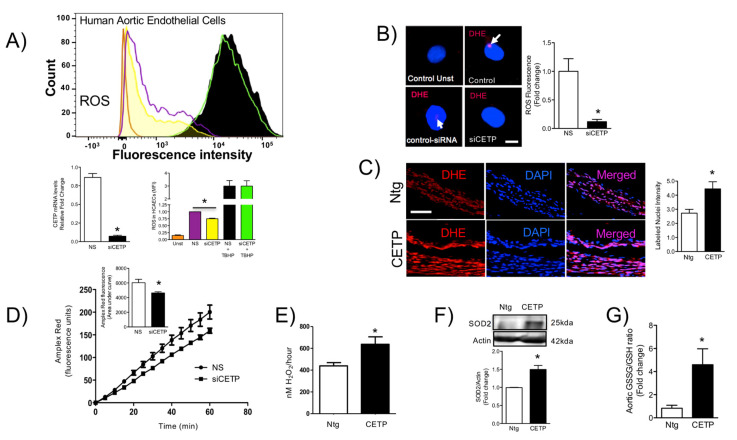Figure 3.
CETP expression induces oxidative stress in vivo and in vitro. (A) mRNA levels of CETP in HAECs transfected with CETP or control scrambled siRNA (* p < 0.0001). In order to measure ROS production, HAECs were transfected with CETP, or control scrambled siRNA and, immediately after, stimulated with TBHP as a positive control. HAECs were then incubated with cellROX and expression of ROS was measured via fluorescent activated cell sorting (FACs). HAECs transfected with siCETP lowered ROS production by 25%. Data are mean ± SEM, three experiments each in duplicate or triplicate, * p < 0.01 by an unpaired Student’s T test. (B,C) Superoxide production was determined in (B) HAECs (n = 10, 2 experiments, * p < 0.01, scale bar = 10 µm) and (C) mouse aortas (n = 3–4, * p < 0.05, scale bar = 50 µm) using dihydroethidine (DHE) probe. The fluorescence signal was evaluated as the intensity of fluorescence per pixel in at least 10 cells or normalized by the vessel area. (D,E) Hydrogen peroxide production measured using Amplex Red probe in HAECs (D) shown as time-course of fluorescence and total area under the curve (n = 6, * p < 0.01) and in mouse aortas (E) shown as total production in 1 h (n = 4–5, * p < 0.05). (F) Protein from aortic lysates was extracted and used to determine superoxide dismutase (SOD2) levels by Western blotting analysis (n = 2 experiments, * p < 0.05). (G) Oxidized/reduced glutathione ratio in aorta, n = 4, * p < 0.05. Data are expressed as mean ± SEM. HAECs, human aortic endothelial cells. CETP, cholesteryl ester transfer protein. NS, non-silenced. siCETP, silenced CETP, FACs, fluorescence assisted cell sorted, TBHP, tert-Butyl hydroperoxide.

